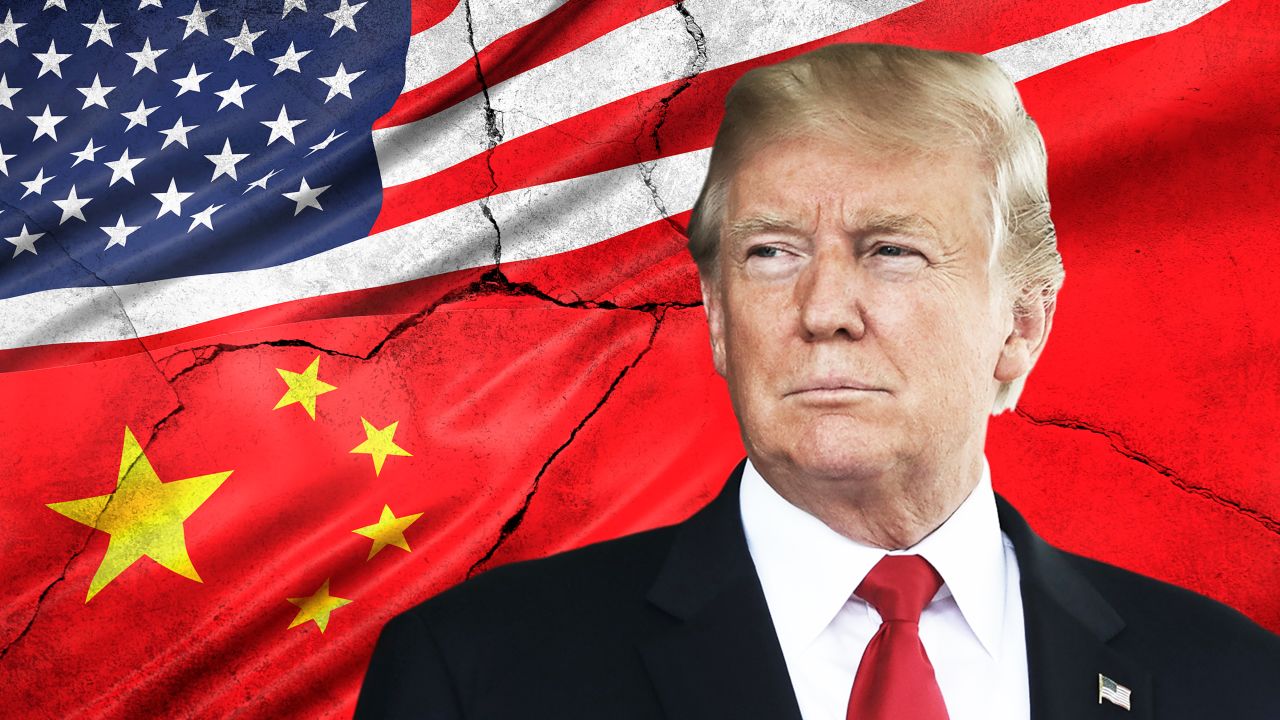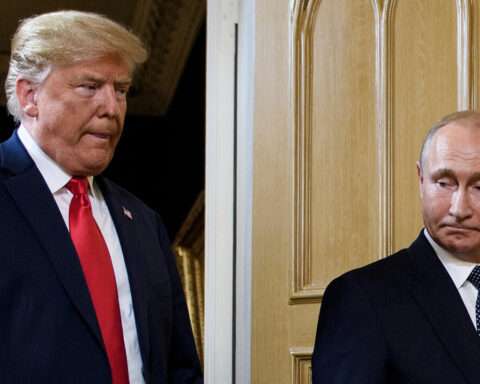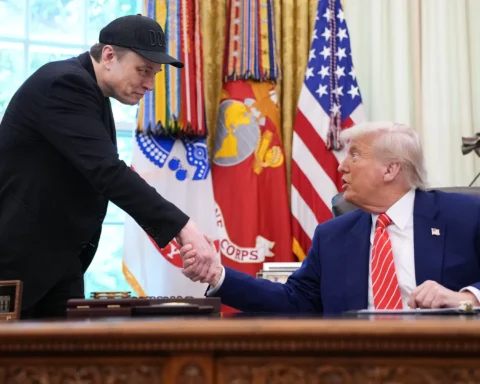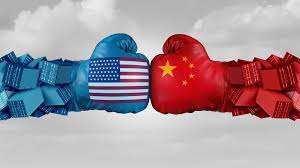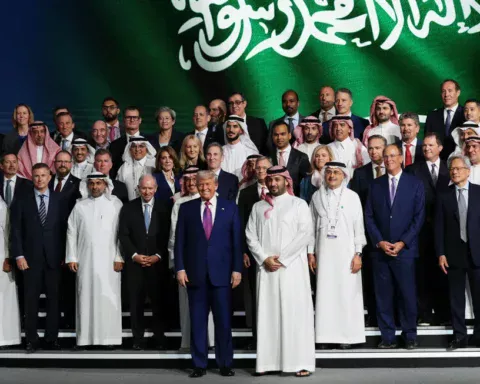President Donald Trump’s trade war with China has intensified, deepening a high-stakes economic showdown that could reshape global commerce and jolt both nations’ economies.
With tariffs soaring—U.S. duties on Chinese goods now at 145%, matched by Beijing’s 125% retaliatory levies—the conflict risks sparking inflation, disrupting supply chains, and erasing trillions from stock markets.
As Trump pushes to reframe America’s trade relationship with its biggest rival, the fallout is already rattling consumers, businesses, and allies worldwide.
It was April 14, 2025, when the latest salvo in this tit-for-tat escalation underscored the urgency of de-escalation. The conflict, rooted in Trump’s campaign promises to revive U.S. manufacturing and curb China’s economic dominance, has spiraled into a global concern.
From Wall Street to Shenzhen’s ports, the stakes are enormous, with fears of recession and inflation mounting. While Trump insists his strategy will force concessions from Chinese President Xi Jinping, critics warn the gamble could inflict lasting damage on American households and beyond.
A Trade War Reignited
Trump’s second term began with a bold economic agenda, centered on tariffs as a tool to protect American jobs. In February 2025, he imposed a 10% tariff on all Chinese goods, building on measures from his first term and the Biden administration.
By early April, the U.S. raised duties to 125%, citing China’s role in fentanyl production and long-standing grievances over market access and intellectual property theft. China retaliated swiftly, hiking tariffs on U.S. imports to 84% before matching the U.S. at 125% on April 11, targeting agricultural products like soybeans and pork.
The escalation has disrupted trade flows. U.S. farm exports to China, valued at $24 billion last year, face collapse, reminiscent of the 2018 trade war when sales dropped to $9.2 billion. Beijing’s Commerce Ministry called U.S. tariffs a “joke” that violates global trade rules, filing a World Trade Organization complaint.
Trump, undeterred, posted on Truth Social that China “wants to make a deal, badly,” predicting Xi would soon negotiate. Yet Beijing shows no signs of yielding, with Xi declaring China “not afraid” of economic pain.
Deepening Showdown with China Carries Huge Economic Stakes
The trade war’s ripple effects are profound. Global stock markets have shed trillions, with the S&P 500 down 9% from its recent high and the Dow plunging 2,200 points in a single week—its worst since 2020.
U.S. consumers face rising prices for electronics, clothing, and furniture, as China supplies much of America’s retail goods. A University of Michigan survey showed consumer sentiment at its lowest since 1981, with inflation fears spiking. “Tarifflation is real,” said Bill Adams, chief economist at Comerica Bank, warning of higher costs ahead.
China’s $20 trillion economy, already grappling with deflation and a property crisis, faces a projected 4.5% growth rate in 2025, below its 5% target. Analysts at UBS estimate Trump’s tariffs could shave 1.3 percentage points off China’s GDP, forcing Beijing to lean on domestic stimulus. Manufacturers like Jerry Jiao, who makes bathtubs in China, have cut jobs to offset export losses. Yet China’s trillion-dollar trade surplus gives it leverage, and Xi’s government is exploring yuan depreciation to boost exports, a move that could further inflame tensions.
Trump’s Strategy: Brinkmanship or Blunder?
Trump’s approach draws on his real estate days, where raising stakes forced opponents to fold. “I think Xi is a very smart guy, and we’ll end up making a good deal,” he told reporters on April 9. His team, including Treasury Secretary Scott Bessent and economic adviser Kevin Hassett, argues that U.S. economic might will compel China to address issues like trade imbalances and industrial espionage. Hassett, on CNN’s “State of the Union,” described a “nascent” process for China, distinct from smoother talks with allies like Japan and India.
Critics, however, see improvisation over strategy. When asked about his endgame, Trump demurred, saying only that China had “ripped off” America for decades. Economists like Jason Furman, a former Obama adviser, warn that tariffs are inflationary, canceling out relief from Trump’s pause on duties for other nations. The interconnected U.S.-China economies—American firms rely on Chinese parts, while China buys U.S. debt—mean both sides face pain. “This is a grueling test of who can endure more,” said Scott Lincicome of the Cato Institute.
Global Ripples and Domestic Costs
The trade war’s fallout extends beyond the U.S. and China. Europe, caught in the crossfire, has rolled out €50 billion in “tariff shields” to protect its exporters. Mexico and Canada, initially hit by U.S. tariffs, secured exemptions after tense talks, but their economies remain vulnerable. Taiwan, a key U.S. ally, fears collateral damage, with Sen. Rand Paul warning that severed trade with China could destabilize the island. “Trade is good for our foreign policy and consumers,” Paul said on April 10.
At home, Trump’s tariffs threaten to undermine his political standing. A CBS poll on April 13 showed 56% of Americans disapprove of his economic handling, with 60% unhappy about inflation. Retailers like Walmart and Target have warned of price hikes, while small businesses, reliant on Chinese imports, face uncertainty. “Customers are pausing orders,” a transportation equipment manager told the Institute for Supply Management, citing tariff chaos. Retirement accounts have taken a hit, with trillions wiped from global markets since early April.
China’s Resilience and Response
China’s economy, though strained, is better equipped than most to weather tariffs, says economist Jayati Ghosh. Beijing is boosting domestic demand with low interest rates and local government borrowing, while seeking trade partners in the Global South. A propaganda video from China’s Foreign Ministry, set to John Lennon’s “Imagine,” contrasts U.S. “hegemonism” with a Chinese-led world of “equality.” Manufacturers are relocating to Vietnam and Thailand, though U.S. tariffs on those nations—46% and 36%, respectively—limit the workaround.
Still, China faces challenges. Its export sector, a growth driver, is projected to shrink by 4.5%, and factory layoffs are rising. “I’ve done all this work for nothing,” said Jin Chaofeng, a furniture maker who moved production to Vietnam only to face new levies. Beijing’s defiance—calling U.S. tariffs a “numbers game”—signals a long fight, with Xi prioritizing national pride over immediate concessions.
Allies and Alternatives
Trump’s team has floated isolating China by strengthening trade with allies, but his “America First” stance complicates this. Japan, South Korea, and Vietnam are in talks with Washington, but Trump’s earlier tariffs on Canada and the EU alienated potential partners. Treasury Secretary Bessent suggested on Fox Business that allies could pressure China, yet strained relations—exacerbated by Trump’s demand that Israel eliminate its trade deficit—undermine this plan. “He’s alienated nations we’d need,” said a former trade official.
Some see negotiation as the only exit. Trump’s invitation to Xi for his inauguration hints at openness to a deal, similar to the 2020 Phase 1 agreement. But Xi’s refusal to call, coupled with China’s WTO complaint, suggests talks are distant. “Beijing doesn’t want to go to the brink, but neither does it blink,” said Zhiwu Chen, a finance professor at HKU Business School.
A Fragile Future
The trade war’s trajectory hinges on whether Trump’s gamble pays off. If he secures concessions—say, better market access or reduced subsidies—he could claim a historic win. But failure risks a prolonged standoff, with economists warning of a global recession. The Federal Reserve, focused on inflation, faces pressure as consumer prices climb. “Tariffs are a tax hike,” said Luke Tilley of Wilmington Trust, predicting economic weakness if duties persist.
For Americans, the immediate pain is clear: higher costs, market volatility, and job uncertainty in trade-dependent sectors. China, too, braces for slower growth, but its state-driven economy offers cushions the U.S. lacks. As both leaders dig in, the world watches a showdown that could redefine trade for decades—or cripple it.
Focus keywords: Trump China trade war 2025, US China tariffs economy, Trump Xi Jinping showdown, global market impact tariffs, economic stakes US China conflict


